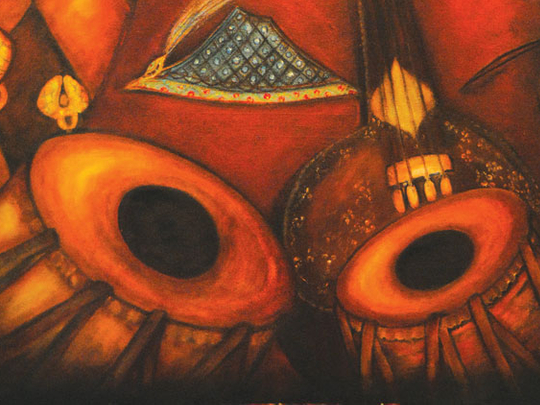
History has not been kind to nawab Wajid Ali Shah, the last ruler of Awadh (present-day Lucknow in North India). He is known as a degenerate ruler who neglected his responsibilities of governance to spend most of his time with dancing girls and at mushairas (poetry-reading sessions) and ultimately gave up his kingdom to the British without a fight. But Malhaar, the UAE's first Indian choir, wants to change this perception with its latest presentation, Jashn-e-Awadh, to be staged at DUCTAC tonight and tomorrow.
The show combines music, dance, theatre and art to celebrate the golden era of culture that flourished in Awadh during the reign of the nawab. It aims to recreate the ambience of the nawab's court through opulent sets, authentic period costumes and live performances of kathak dancing and various styles of classical and semi-classical Indian music.
Jogiraaj Sikidar, who has conceptualised the event, has good reasons to justify his unconventional choice of subject.
"Though he failed politically, the nawab was a gifted poet, playwright, dancer and musician whose patronage revived the art of the classical Indian dance form of kathak and took the classical music styles of thumri and ghazal to new heights.
"During his reign, Awadh flourished as a centre of art and culture and the city of Lucknow still enjoys that reputation. As a group dedicated to showcasing India's rich cultural heritage, Malhaar wants to focus on the various facets of the Lucknow gharana [school of art], which has given many famous dancers and musicians to the country," he says.
"We have done a lot of research and we believe our show will clear many misconceptions about the nawab and his contribution to art and culture," Sikidar added.
Sikidar founded Malhaar two years ago, to bring together UAE residents who share a love of Hindustani classical music. The group has presented several musical concerts in Dubai but this is their most ambitious project. "The show features more than 50 performers and is the first Indian classical concert of this scale to be presented in the region. We are proud of the fact that all the performers are based in the UAE," he says.
To give it a contemporary context, the show is presented in the form of an interaction between a tourist guide from Lucknow and a visitor, who is a young musician and has many misconceptions about the nawab and Lucknowi heritage. Together they discover the musical and cultural legacy of the nawab and bridge the gap between the bygone era and contemporary Indian music.
The show is divided into nine segments, depicting various aspects of the life of the nawab. Some recreate the music, poetry and dance gatherings at the nawab's court. Others depict his secular nature by enacting the celebrations of Indian festivals such as Holi, in which the nawab, who was a devout Muslim, participated enthusiastically.
The final sequence captures the pathos and pain of the nawab's decision to relinquish his kingdom and go into exile without a fight so as to protect his people from the violence and bloodshed of battle.
The musical part of the show includes traditional Holi songs, classical thumris and beautiful ghazals and some of the nawab's famous compositions, such as Babul Mora, which expresses his pain of leaving his people. But most of the songs are written and composed by Sikidar himself.
The dance sequences have been choreographed by Vaishali Mhaisalkar, founder of Tapasya Centre for Performing Arts in Dubai. "I was excited when Malhaar approached me because this is a great opportunity to be creative. Choreographing the pieces was quite a challenge, because, while some of the dancers are experienced performers, I also have children who have never performed on stage before. The dance pieces include kathak sequences, a Holi celebration and a peacock dance to welcome the monsoon," says the gifted kathak dancer and teacher.
For architect Ushma Shah, the challenge was to design sets and costumes that had the feel of Awadh, yet had a contemporary look. "The lack of reference material was a big hurdle and we have relied on Satyajit Ray's film Shatranj Ke Khiladi to create the ambience of the era," she says. For Lakshman Rao, playing the nawab was one of his most difficult roles. "Singing and acting come naturally to me. But the difficult part was learning the dance moves and getting the body language right," he says. Director Sanjeev Dixit had the task of seamlessly blending together the various elements of the show.
But the biggest challenge for the group was to find sponsorship. "We are a not-for-profit group driven only by our passion for music. We lack the financial resources to do such big shows. It is disheartening that companies in the UAE do not support local talent and we are thankful to Tranworld Group of Companies for supporting this show. We want to appeal to the community to encourage creativity and provide affordable venues and other facilities to UAE-based cultural groups so that we can make the UAE a truly cultural centre of the region," Sikidar says.
Jashn-e-Awadh is on at DUCTAC, Centrepoint auditorium, Mall of the Emirates, today and tomorrow, 6.30pm onwards.
Jyoti Kalsi is a UAE-based art enthusiast.


